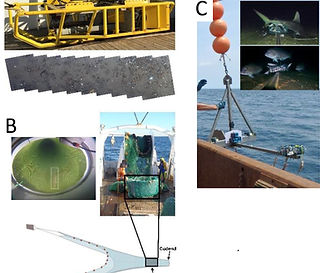DOE Project
Project lead: Liese Siemann, Tasha O'Hara, Farrell Davis, and Luisa Garcia
Partners: Mass Dartmouth's School for Marine Science & Technology and Kitware, Inc.
Funded by: The Department of Energy Office of Energy Efficiency and Renewable Energy
This research project is designed to evaluate the impacts of offshore wind development on commercial fish species and benthic habitats and communities using a suite of state-of-the-art, non-lethal survey tools including an open cod-end video trawl, a towed off-bottom optical survey vehicle, and anchored and ropeless stationary camera systems. The project will provide data on changes in commercial fish and marine invertebrate abundance and distribution, and the relationship of both to habitat changes, the presence of new structures (turbine bases), and changing underwater noise levels. We expect this research to address the challenges of offshore wind development competition with other ocean needs like fishery-independent surveys used for management.
CFF has partnered with multiple highly experienced groups to successfully complete this project. Scientists from the Stokesbury laboratory at the University of Massachusetts Dartmouth School of Marine Science and Technology (SMAST) will conduct video trawl surveys using a system in development since 2013. Their video trawl has been used to survey groundfish stocks in wind energy areas and on important scallop grounds. Of critical importance for this effort, it is towed behind commercial trawl vessels that are capable of working in turbine fields when necessary. Automated detectors for imagery from optical surveys will be developed in collaboration with Kitware, Inc., the developers of Video and Image Analytics for Marine Environments (VIAME), an open-source platform for analysis of underwater imagery, created with initial support from the NOAA Automated Image Analysis Strategic Initiative. VIAME has been used on imagery from HabCam surveys led by CFF and NEFSC and baited video imagery from surveys led by CFF and the Southeast Fisheries Science Center. CFF is also partnering with multiple commercial fishing companies to guarantee that the project has the support of this key group. CFF has a strong working relationship with mobile and fixed gear fishers after more than a decade of collaborative research projects.

Study survey gear. (A) HabCam v3 vehicle and image mosaic. (B) Video trawl schematic and view toward the open cod end. (C) Baited stationary camera system and image captures.
Project survey extent which encompasses the MA/RI wind lease areas.

The first project research trip was completed in June 2024. This trip focused on reducing sediment clouds in the video collected by the SMAST video trawl. Modifying the net by adding a 17-ft extension significantly reduced turbidity and improved the video quality.
Improvement in image quality with the net extension. (A) Image from the 2018 survey using a standard-length net. (B) Image from the June 2024 trip using the elongated net.


